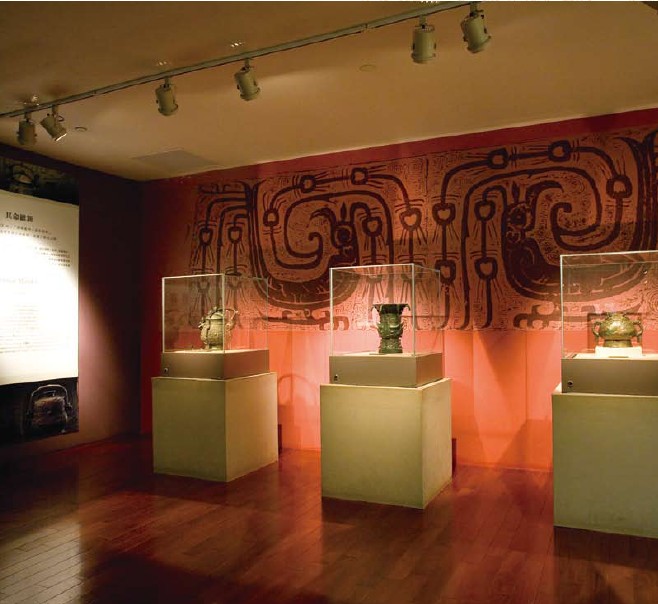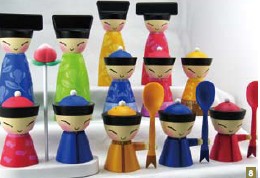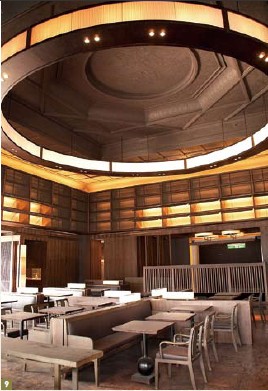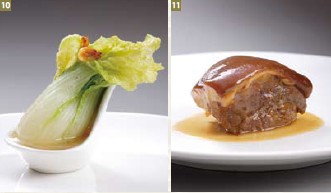The National Palace Museum
By the Song Dynasty, artisans had established the Longquan glaze's signature glossy, greenish color. Sophisticates have long admired both the elegant thin body and ethereal, bluish-green glaze of the Song-era wares, and the thick, vigorous, larger-sized Yuan Dynasty wares. However, this exhibition focuses on Ming pieces--their use in court and unique role in tributary and trade relations between the empire and other nations. Among the Ming creations, those with glossy, rich, green glazes in yellowish or milky tones gained the greatest favor. They usually came in neat, orderly shape and were fully carved with intricate patterns, similar to those of Jingdezhen official wares for the imperial household, clear signs of meticulous and superior workmanship. However, the significance of the Ming celadon was long little known. Only recently have archaeologists unearthed kiln sites with dated shards, verifying historical documents recording Longquan kilns as supplier for and supervised by the early Ming court. Even today, traces of Ming Dynasty Longquan wares often appear in archaeological sites and court collections in Asia, Africa, and Europe. The National Palace Museum is one of Taiwan's top attractions, and one of the world's top museums. If you're in Taiwan on a voyage of discovery into Asian culture, well, then, how is it possible that you don't give yourself at least a day with the greatest Chineseculture treasure extant? See you there. Taipei's National Palace Museum, in the suburban Waishuangxi, has been called one of the premier sites of human culture. From the Song Dynasty on, China's emperors were avid collectors of that land's finest artworks – calligraphy, paintings, sculpture, ceramics, bronzeware, and much more – and the“house collection” of thousands of years is on hand for your delectation at the National Palace Museum. The mysterious trove became public property with the advent of China's republican period in the early 1900s, and the National Palace Museum was opened in Beijing in 1925, dedicated to display and collation. The massive treasury, with relatively few pieces gone missing, was moved to safety on Taiwan in 1948, at the height of the Chinese Civil War. In 1965, it went back on public display in an impressive new home specially built for it – the“Zhongshan Museum”, now called the National Palace Museum. In its 40-plus years here, the Taipei facility has continually been upgraded to keep up with advances in museum facilities and technique. Today, visitors are provided a world-class aesthetic and cultural experience.
Taipei's National Palace Museum, in the suburban Waishuangxi, has been called one of the premier sites of human culture. From the Song Dynasty on, China's emperors were avid collectors of that land's finest artworks – calligraphy, paintings, sculpture, ceramics, bronzeware, and much more – and the“house collection” of thousands of years is on hand for your delectation at the National Palace Museum. The mysterious trove became public property with the advent of China's republican period in the early 1900s, and the National Palace Museum was opened in Beijing in 1925, dedicated to display and collation. The massive treasury, with relatively few pieces gone missing, was moved to safety on Taiwan in 1948, at the height of the Chinese Civil War. In 1965, it went back on public display in an impressive new home specially built for it – the“Zhongshan Museum”, now called the National Palace Museum. In its 40-plus years here, the Taipei facility has continually been upgraded to keep up with advances in museum facilities and technique. Today, visitors are provided a world-class aesthetic and cultural experience. The types of artifacts are many and the number is jaw-dropping—over 700,000 pieces. Only a portion displayed at any one time, with the majority stored in massive cooled vaults dug right into the mountainside behind the museum. The core of the treasury today remains the imperial collection, but the trove now also includes priceless works from the cultures of other peoples beyond China's, including those of Taiwan. In terms of exhibit facilities, the museum has an immense main hall and a Library Building, completely refurbished in recent years, and the magnificent Zhishan Garden , an expansive oasis that allows you to step directly into the Song Dynasty world of ornamental landscaping. Sprawled in tightly controlled fashion over 5,000 ping (1 ping equals 36 sq. ft.), after stepping back in time and into such a visually fragrant mini-universe, you may well be less than eager to hurry back.
The types of artifacts are many and the number is jaw-dropping—over 700,000 pieces. Only a portion displayed at any one time, with the majority stored in massive cooled vaults dug right into the mountainside behind the museum. The core of the treasury today remains the imperial collection, but the trove now also includes priceless works from the cultures of other peoples beyond China's, including those of Taiwan. In terms of exhibit facilities, the museum has an immense main hall and a Library Building, completely refurbished in recent years, and the magnificent Zhishan Garden , an expansive oasis that allows you to step directly into the Song Dynasty world of ornamental landscaping. Sprawled in tightly controlled fashion over 5,000 ping (1 ping equals 36 sq. ft.), after stepping back in time and into such a visually fragrant mini-universe, you may well be less than eager to hurry back. After touring the museum's display facilities, many folk look to continue in their quest for cultural enlightenment and refinement by repairing to the imperial-style San-hsi-t'ang tea room on the main hall's 4th level, where classical-style teas and foods are served in classical fashion. Your sense of the elegant past will be heightened on Saturday afternoons from 13:30 to 15:30, when a classical Chinese-music ensemble takes the floor, and the timeless Chinese zither the star attraction.
After touring the museum's display facilities, many folk look to continue in their quest for cultural enlightenment and refinement by repairing to the imperial-style San-hsi-t'ang tea room on the main hall's 4th level, where classical-style teas and foods are served in classical fashion. Your sense of the elegant past will be heightened on Saturday afternoons from 13:30 to 15:30, when a classical Chinese-music ensemble takes the floor, and the timeless Chinese zither the star attraction. Beyond its many permanent exhibitions, with those displaying the imperial collection arranged in easy-to-follow, chronologically ordered by dynasty, there are also numerous dazzling temporary exhibits. Themes are original and eclectic, and many are loan exhibits from the world's leading cultural institutions. From the vast permanent collection, the people have chosen the“Mao-kung Ting”(a sacrificial bronze tripod vessel),“Jadeite Cabbage with Insects”, and“Meat-shaped Stone” as their favorite cultural icons, and come in terrific numbers to enjoy them. Collectively they've been dubbed the“NPM's three treasures”. Note, however, that there is still competition for placement in the big three, and some will tell you that the Mao-kung Ting must be replaced with the painting“Along the River during the Qingming Festival”. Guess you'll just have to get up there and decide for yourself. Whatever your opinion, it's clear that the Jadeite Cabbage and Meat-shaped Stone, both remarkably vivid and lifelike, top the lists, as evidenced by the enthusiastic, marvelling crowds that constantly surround them. So be patient, and you shall be rewarded—trust us.
Beyond its many permanent exhibitions, with those displaying the imperial collection arranged in easy-to-follow, chronologically ordered by dynasty, there are also numerous dazzling temporary exhibits. Themes are original and eclectic, and many are loan exhibits from the world's leading cultural institutions. From the vast permanent collection, the people have chosen the“Mao-kung Ting”(a sacrificial bronze tripod vessel),“Jadeite Cabbage with Insects”, and“Meat-shaped Stone” as their favorite cultural icons, and come in terrific numbers to enjoy them. Collectively they've been dubbed the“NPM's three treasures”. Note, however, that there is still competition for placement in the big three, and some will tell you that the Mao-kung Ting must be replaced with the painting“Along the River during the Qingming Festival”. Guess you'll just have to get up there and decide for yourself. Whatever your opinion, it's clear that the Jadeite Cabbage and Meat-shaped Stone, both remarkably vivid and lifelike, top the lists, as evidenced by the enthusiastic, marvelling crowds that constantly surround them. So be patient, and you shall be rewarded—trust us. Beyond this, we specially recommend you make time for Wang Xi-zhi's “Timely Clearing after Snowfall”, Fan Kuan's “Travelers among Mountains and Streams”, and Ming Cheng-hua's “Doucai Cup with Chicken Design”, all works that will leave you spellbound and marvelling at how very high human creativity can soar.
Beyond this, we specially recommend you make time for Wang Xi-zhi's “Timely Clearing after Snowfall”, Fan Kuan's “Travelers among Mountains and Streams”, and Ming Cheng-hua's “Doucai Cup with Chicken Design”, all works that will leave you spellbound and marvelling at how very high human creativity can soar. To satisfy popular demand, the museum brings out a constant stream of new publications and souvenir items. Each month, both a magazine and an academic journal roll off the presses, and there is also a photographic collection, allowing museum fans to“bring the NPM treasures home.”The souvenirs come in splendid variety, including attractive replicas and miniatures of the famous artworks, and this year, the museum is specially rolling out a series of cute commercial items with the Jadeite Cabbage as the theme. And don't think they're just for kids—take a gander during a visit to the souvenir shop and we promise you won't be leaving empty-handed.
To satisfy popular demand, the museum brings out a constant stream of new publications and souvenir items. Each month, both a magazine and an academic journal roll off the presses, and there is also a photographic collection, allowing museum fans to“bring the NPM treasures home.”The souvenirs come in splendid variety, including attractive replicas and miniatures of the famous artworks, and this year, the museum is specially rolling out a series of cute commercial items with the Jadeite Cabbage as the theme. And don't think they're just for kids—take a gander during a visit to the souvenir shop and we promise you won't be leaving empty-handed. Also extremely popular is the clever series of upscale-dining dishes at the museum's high-end Silk Palace restaurant, which opened in June, 2008. Eight art masterpieces from the museum that cannot be, of course, eaten or even touched – such as the Jadeite Cabbage, Meat-shaped Stone, and“White jade branch of elegant lychee” (or White Jade Bitter Gourd) – are brought to your table as delicious chef-prepared dishes. Well, not the actual artworks, of course, but farm-fresh variants you can actually sink your teeth into.
Also extremely popular is the clever series of upscale-dining dishes at the museum's high-end Silk Palace restaurant, which opened in June, 2008. Eight art masterpieces from the museum that cannot be, of course, eaten or even touched – such as the Jadeite Cabbage, Meat-shaped Stone, and“White jade branch of elegant lychee” (or White Jade Bitter Gourd) – are brought to your table as delicious chef-prepared dishes. Well, not the actual artworks, of course, but farm-fresh variants you can actually sink your teeth into. Another special treat that is bringing visitors substantial aesthetic and intellectual satisfaction is the current“Green: Longquan Celadon of the Ming Dynasty”exhibit, which launched Jan. 25 and will close Oct. 15. The Longquan kilns of Longquan County in the southwest of China's Zhejiang Province began producing celadon wares of renown during the Song Dynasty. Their traditions were faithfully passed down through the Yuan and Ming dynasties before the craftsmanship began to pale. It was during the Ming that Europeans learned of the wares, soon becoming passionately enamored with them, and the adoring name“celadon”was bestowed, meaning“beautiful lad,”reference to Celadon, an Arcadian-type shepherd character in Honore d'Urfe's French romance L'Astree (1627).
Another special treat that is bringing visitors substantial aesthetic and intellectual satisfaction is the current“Green: Longquan Celadon of the Ming Dynasty”exhibit, which launched Jan. 25 and will close Oct. 15. The Longquan kilns of Longquan County in the southwest of China's Zhejiang Province began producing celadon wares of renown during the Song Dynasty. Their traditions were faithfully passed down through the Yuan and Ming dynasties before the craftsmanship began to pale. It was during the Ming that Europeans learned of the wares, soon becoming passionately enamored with them, and the adoring name“celadon”was bestowed, meaning“beautiful lad,”reference to Celadon, an Arcadian-type shepherd character in Honore d'Urfe's French romance L'Astree (1627).Information National Palace Museum
Tel: (02) 2881-2021
Add: 221, Sec. 2, Chih-shan Rd., Shilin District
Hours: 09:00-17:00; extended hours Sat, to 20:30
(open daily all year)
Website: www.npm.gov.tw/en/
Transportation:
Take the MRT Tamsui line to Shilin Station, then transfer to bus no. 255, 304, Red 30, or small-sized public bus no. 18 or 19

![Taiwan.gov.tw [ open a new window]](/images/egov.png)
